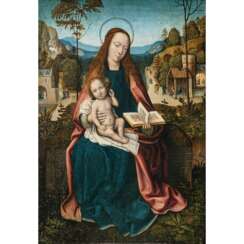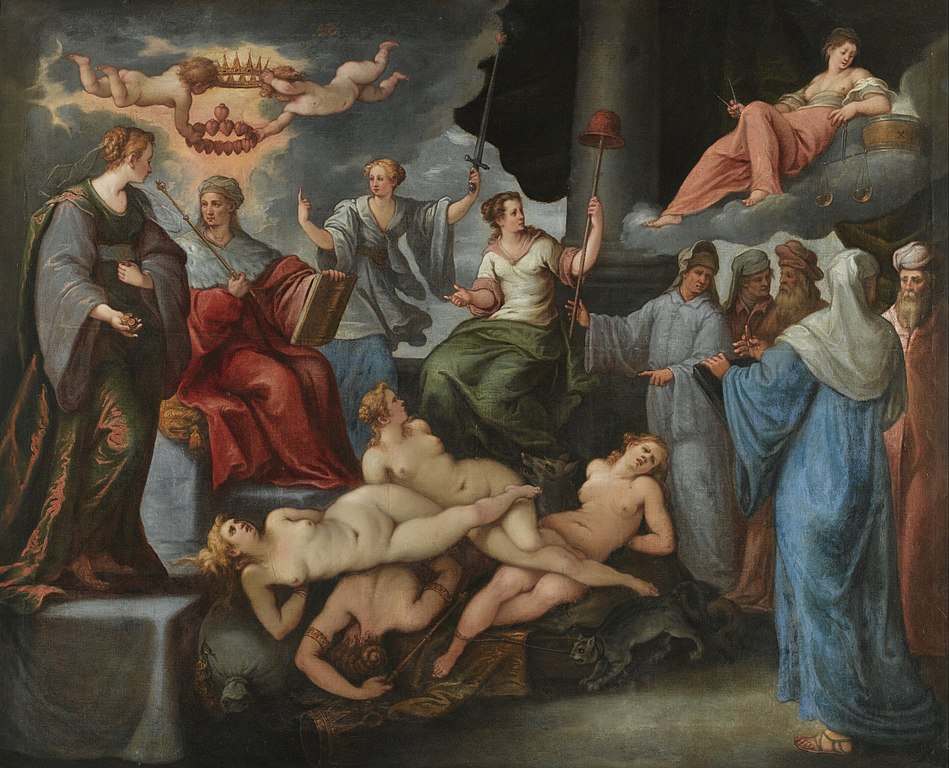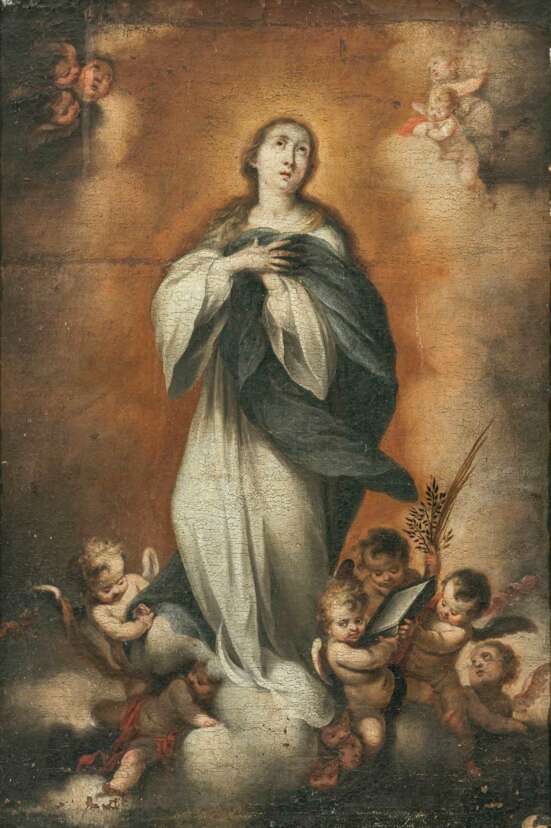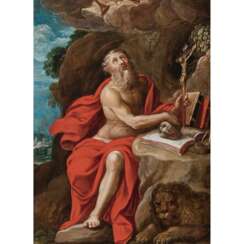
Paintings 15th -18th century — GEMÄLDE UND GRAPHIKEN VOM 15. BIS 20. JAHRHUNDERT

Quentin Matsys (Dutch: Quinten Matsijs), a Flemish painter born around 1466 in Leuven, is recognized as a pivotal figure in the Early Netherlandish tradition and a founder of the Antwerp school of painting. His initial training as an ironsmith in his father's workshop lent a unique craftsmanship to his artistic endeavors. Matsys' works, which often contained religious themes and satirical elements, were instrumental in the transition from medieval to Renaissance art in northern Europe.
Matsys' early works exhibit the influence of Hans Memling, and later, his exposure to Italian Renaissance artists, especially Leonardo da Vinci, is evident in his refined technique. This amalgamation of Northern European and Italian influences resulted in a distinctive style that earned him the reputation as the leading painter in Antwerp during the early 16th century.
Today, Matsys' masterpieces are housed in prestigious institutions like the National Gallery in London, serving as a testament to his enduring legacy. His contributions to the art world resonate with collectors and historians alike, who admire his innovative blend of technical skill and evocative expression.

Tiziano Vecellio, an Italian Renaissance painter from Venice, stands out as a pivotal figure in the art world, renowned for his versatility across various genres like portraits, landscapes, and religious subjects. His influence on the development of Western art, particularly through his revolutionary use of color, is profound and long-lasting.
Born around 1488/90 in Pieve di Cadore, part of the then Republic of Venice, Titian's talent was evident early on. He began his artistic journey in the studio of the Bellini brothers in Venice, later joining forces with Giorgione, another influential painter of the time. This collaboration marked the beginning of a distinguished career that would see Titian become the most sought-after painter in Europe, working for nobility, the Habsburgs, and the papacy.
Titian's style evolved significantly throughout his career. He initially gained recognition for his vibrant, luminous colors and later became famous for his loose brushwork and subtle tonality. This shift was not just a matter of aesthetics but also represented a deeper understanding of color and light. Titian's approach to painting, particularly his use of colore, where he juxtaposed colors to define compositions, contrasted sharply with the line-focused disegno technique of the time. This method contributed significantly to the distinctiveness of Venetian art.
Among his many patrons, Emperor Charles V and his son, Philip II of Spain, were perhaps the most notable. As their official painter, Titian created numerous portraits and mythological works that were celebrated for their psychological depth and expressive use of color. His 'poesie' series for Philip II, including famous works like "Diana and Actaeon," showcased his skill in portraying mythological narratives with a sense of drama and sensuality.
Titian's later works, created in the 1560s and 1570s, are particularly revered for their experimental nature, pushing his art towards what has been termed 'magic impressionism'. These works, like "The Death of Actaeon" and the unfinished "Pietà", demonstrate a radical departure from his earlier style and reflect a continued evolution even in his later years.
For art collectors and experts, Titian's oeuvre represents a crucial link in the history of European art, illustrating the transition from the Renaissance to a more modern, expressive form of painting. His mastery of color and light, combined with his ability to convey deep emotional resonance, continues to influence artists and captivate viewers centuries later.
To stay updated on artworks and auction events related to Tiziano Vecelli, consider signing up for updates. This subscription will ensure you are informed about new product sales and auction events related to this remarkable artist.

Jacopo Bassano or Jacopo da Ponte was an Italian painter of the Venetian school. He painted biblical scenes and portraits in the late Renaissance and Mannerist style, with a slight touch of Baroque. Bassano was quite realistic in his depictions of everyday objects, animals, homes and landscapes.

Jacopo Bassano or Jacopo da Ponte was an Italian painter of the Venetian school. He painted biblical scenes and portraits in the late Renaissance and Mannerist style, with a slight touch of Baroque. Bassano was quite realistic in his depictions of everyday objects, animals, homes and landscapes.

Hans Rottenhammer or Johannes Rottenhammer was a German painter and master of cabinet genre paintings.
After completing his studies as court painter to the Munich royal court, Rottenhammer spent nearly a decade in Venice, and his art bears the influence of Venetian masters such as Tintoretto and Veronese. Rottenhammer opened a studio in the city and attracted patrons and collectors as well as students and followers. In the early 1600s he joined the guild of Venetian artists. It was in Venice that Rottenhammer became famous for his cabinet paintings. These were small works, executed on copper and usually dealing with religious or mythological themes popular at the time.

Benjamin Gerritszoon Cuyp was a Dutch painter of the Golden Age, was a member of the Dordrecht Guild of St. Luke, brother of Jacob Gerritsz. Cuyp. He was very prolific and known for allegorical works, genre, war and biblical scenes. He also painted landscapes. Kaipa's work was influenced by Rembrandt's style.

Benjamin Gerritszoon Cuyp was a Dutch painter of the Golden Age, was a member of the Dordrecht Guild of St. Luke, brother of Jacob Gerritsz. Cuyp. He was very prolific and known for allegorical works, genre, war and biblical scenes. He also painted landscapes. Kaipa's work was influenced by Rembrandt's style.

Giovanni Battista Gaulli was an Italian artist working in the High Baroque and early Rococo periods. He is best known for his grand illusionistic vault frescos in the Church of the Gesù in Rome, Italy. His work was influenced by Gian Lorenzo Bernini.

Frans Francken the Younger was a distinguished Flemish painter of the Baroque period, celebrated for his versatility and innovation in the art scene of the early 17th century. Born in 1581 in Antwerp, where he also died in 1642, Francken hailed from the prolific Francken family of artists, establishing himself as the most prominent among them. His contribution to Flemish art includes a wide array of subjects, spanning large altarpieces for churches to intricate cabinet pictures featuring historical, mythological, or allegorical themes.
Francken's work is particularly noted for his creation of collectors' cabinet paintings, a genre that depicted the interiors of collectors filled with art, curiosities, and natural specimens, embodying the era's intellectual pursuits and the burgeoning culture of connoisseurship. Moreover, Francken was instrumental in the development of singeries, humorous paintings featuring monkeys engaging in human activities, critiquing the follies of mankind through satire. His collaborative efforts with other artists enriched his work, allowing him to incorporate figures and narrative depth into various compositions, seamlessly blending his expertise with the landscapes, architectural settings, and still lifes created by his contemporaries.
Francken's artistic legacy is marked by his successful workshop, his role as a master in the Antwerp Saint Luke's Guild, and his significant influence on the development of new subject matter and genres within Flemish painting. His works, such as "Mankind's Eternal Dilemma: The Choice Between Virtue and Vice," remain celebrated for their detailed craftsmanship and symbolic richness, housed in prestigious museums including the Museum of Fine Arts, Boston.
For collectors and art history aficionados, Francken's oeuvre offers a rich tapestry of Baroque artistry, reflecting the dynamism of 17th-century Flemish culture and the depth of humanistic and religious themes explored during the period.
To delve deeper into the world of Frans Francken the Younger and to stay updated on new discoveries, sales, and auction events related to his works, consider signing up for specialized updates. This subscription is tailored for enthusiasts eager to explore the intersections of art, history, and culture, promising insightful content on one of Flemish art's most influential figures.



























































